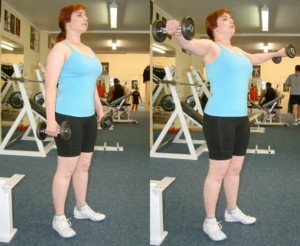
Here’s how to make lateral raises, a.k.a., dumbbell side lifts, safe to avoid injury.
Lateral raises can be done safely without threat of injury, by following my guidelines. There are different ways to do lateral raises.
The most common way is with a dumbbell in each hand, with the palms facing downwards, or partially downwards and partially towards your front.
Subtle differences in body position can increase, or decrease, risk of injury from doing lateral raises, which target the deltoid (shoulder) muscles.
If you have a good pair of shoulders (solid tendons), it’s not likely that lateral raises will cause injury.
The lateral raise is a relatively safe routine, but this doesn’t mean it can’t create problems in someone who has a pre-existing problem with their shoulders.
If you have pre-existing rotator cuff issues, then yes, lateral raises can be a problem.
To minimize rotator cuff pain, and to minimize getting any first-time rotator cuff problems, keep your hands in either neutral position (palms completely facing towards your front while holding the dumbbells), or in a supine position (facing ceiling while holding dumbbells).
If you choose the supine position, make sure not to bend your elbows too much; this might happen instinctively.
But doing this will take recruitment away from the shoulders and transfer some of it to the biceps.
Another way to minimize injury is to do lateral raises not completely laterally, but rather, slightly angled towards the front.
Imagine the lateral line as the 90 degree mark, and imagine that directly in front of you is the zero degree mark.
Raise your arms so that they are smack in between these two imaginary markings — at 45 degrees. This is not quite a lateral raise, but not quite a frontal raise, but rather, a fusion of the two.
But to get more of the lateral aspect of the raise, you can lift your arms out at between the 45 degree and 90 degree mark…say, at about 70 degrees.
This modification of the angling will take some stress off the rotator cuff tendons.
Another way to make lateral raises safer is to use a lateral raise machine, rather than dumbbells. However, I don’t mean use this apparatus the way it’s “meant” to be used.
The way it’s designed is for the user to lift with the upper part of the arms, while their lower arms are bent, forming a 90 degree angle at the elbow joint, the lower arms parallel with floor at the top of the lateral raise movement, palms facing floor at this point also.
(Depending on the machine, your hands may be gripping handles.) This indeed is a lateral raise, but this kind of arm position can be hard on someone with rotator cuff problems.
Do this instead: Lift the pads with biceps against the pads. This means that at the start, your palms will be facing the ceiling. If the machine has handles, don’t use them.
Nobody says you must grip these handles. Minimize the bend at the elbow joint. Now lift.
You will immediately feel less strain on the shoulders, yet at the same time, you will feel your shoulder muscles getting worked.
Keep lifting till your upper arms are parallel or a little past parallel with the floor.
You just did a modified lateral raise that is much easier on the rotator cuff tendons.
Another variation of the lateral raise is to use a dual pulley system.
The negative segment is much easier on shoulder tendons, though the positive phase can be quite challenging.
When doing standing lateral raises, always keep feet flat on the floor, legs slightly bent and shoulder width or so apart. Keep shoulders as relaxed as possible; don’t tense them.
 Lorra Garrick is a former personal trainer certified by the American Council on Exercise. At Bally Total Fitness she trained clients of all ages for fat loss, muscle building, fitness and improved health.
Lorra Garrick is a former personal trainer certified by the American Council on Exercise. At Bally Total Fitness she trained clients of all ages for fat loss, muscle building, fitness and improved health.
.


























